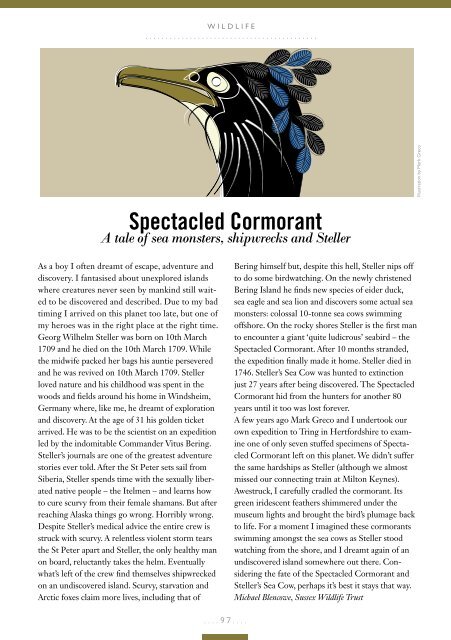Viva Brighton Issue #66 August 2018
Create successful ePaper yourself
Turn your PDF publications into a flip-book with our unique Google optimized e-Paper software.
WILDLIFE<br />
...........................................<br />
Spectacled Cormorant<br />
A tale of sea monsters, shipwrecks and Steller<br />
Illustration by Mark Greco<br />
As a boy I often dreamt of escape, adventure and<br />
discovery. I fantasised about unexplored islands<br />
where creatures never seen by mankind still waited<br />
to be discovered and described. Due to my bad<br />
timing I arrived on this planet too late, but one of<br />
my heroes was in the right place at the right time.<br />
Georg Wilhelm Steller was born on 10th March<br />
1709 and he died on the 10th March 1709. While<br />
the midwife packed her bags his auntie persevered<br />
and he was revived on 10th March 1709. Steller<br />
loved nature and his childhood was spent in the<br />
woods and fields around his home in Windsheim,<br />
Germany where, like me, he dreamt of exploration<br />
and discovery. At the age of 31 his golden ticket<br />
arrived. He was to be the scientist on an expedition<br />
led by the indomitable Commander Vitus Bering.<br />
Steller’s journals are one of the greatest adventure<br />
stories ever told. After the St Peter sets sail from<br />
Siberia, Steller spends time with the sexually liberated<br />
native people – the Itelmen – and learns how<br />
to cure scurvy from their female shamans. But after<br />
reaching Alaska things go wrong. Horribly wrong.<br />
Despite Steller’s medical advice the entire crew is<br />
struck with scurvy. A relentless violent storm tears<br />
the St Peter apart and Steller, the only healthy man<br />
on board, reluctantly takes the helm. Eventually<br />
what’s left of the crew find themselves shipwrecked<br />
on an undiscovered island. Scurvy, starvation and<br />
Arctic foxes claim more lives, including that of<br />
Bering himself but, despite this hell, Steller nips off<br />
to do some birdwatching. On the newly christened<br />
Bering Island he finds new species of eider duck,<br />
sea eagle and sea lion and discovers some actual sea<br />
monsters: colossal 10-tonne sea cows swimming<br />
offshore. On the rocky shores Steller is the first man<br />
to encounter a giant ‘quite ludicrous’ seabird – the<br />
Spectacled Cormorant. After 10 months stranded,<br />
the expedition finally made it home. Steller died in<br />
1746. Steller’s Sea Cow was hunted to extinction<br />
just 27 years after being discovered. The Spectacled<br />
Cormorant hid from the hunters for another 80<br />
years until it too was lost forever.<br />
A few years ago Mark Greco and I undertook our<br />
own expedition to Tring in Hertfordshire to examine<br />
one of only seven stuffed specimens of Spectacled<br />
Cormorant left on this planet. We didn’t suffer<br />
the same hardships as Steller (although we almost<br />
missed our connecting train at Milton Keynes).<br />
Awestruck, I carefully cradled the cormorant. Its<br />
green iridescent feathers shimmered under the<br />
museum lights and brought the bird’s plumage back<br />
to life. For a moment I imagined these cormorants<br />
swimming amongst the sea cows as Steller stood<br />
watching from the shore, and I dreamt again of an<br />
undiscovered island somewhere out there. Considering<br />
the fate of the Spectacled Cormorant and<br />
Steller’s Sea Cow, perhaps it’s best it stays that way.<br />
Michael Blencowe, Sussex Wildlife Trust<br />
....97....


















